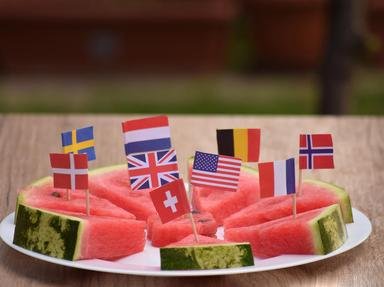Quiz Answer Key and Fun Facts
1. The coat of arms of this country is essentially an inversion of its flag, which has the same colours as the shield (only horizontal) with the 'Eagle of Saladin' centered in the white stripe.
Which Arab country's coat of arms is this?
2. Legend has it that Lech, the founder of this country, saw a white eagle in its nest just as the setting sun's rays touched it, giving its wings a golden fringe. He decided to settle at that location, and took the white eagle as his emblem.
This is the coat of arms of which European country?
3. The 'Hawk of Quraish' was chosen for this country's emblem, including seven tail feathers and seven stars around the circular rendition of the national flag.
Which country, comprised of seven constituent parts, does this represent?
4. This emblem is the legendary Garuda, used as a symbol for this country's royalty for centuries.
Called the 'Phra Khrut Pha', this is the emblem for which Asian nation?
5. The emblem for this country is a variation on its flag, adding the helmet of Skanderbeg surmounted with billy goat's horns.
Which European country?
6. Another national emblem using the legendary Garuda, this one also has a shield with five symbols representing the principles of the nation's ideology.
Called the 'Garuda Pancasila', this is the emblem of which nation of islands?
7. In this coat of arms, the eagle is holding a hammer and a sickle, representing the working class and farmers. The broken chain was added in 1945, signifying the liberation from German occupation in World War II.
Along with the shield displaying the nation's flag, this is the coat of arms of which country?
8. The double-headed eagle has been used as the heraldic device for this country since Ivan III in the 15th century. The shield in the center is a representation of the country's patron St. George Martyr the Victorious slaying the dragon.
Which country?
9. Rather than use the 'Eagle of Saladin' or the 'Hawk of Quraish' in their emblem, this country chose the (locally abundant) secretary bird, along with a shield from the time of Mahdi Muhammad Ahmad (who ruled the region in the 19th century).
Which African nation uses this emblem?
10. Bearing the same colours as its flag, this coat of arms was originally used by the Weimar Republic (1919-1935), then reintroduced in 1950.
Known as the Bundesadler, this is the coat of arms for which European country?
11. Similar to our first coat of arms, this country uses the same 'Eagle of Saladin' in a different colour scheme, along with the nation's flag represented on the shield (vertically).
Which contested Middle Eastern country does this represent?
12. A golden aquila is the centerpiece of this coat of arms, along with a shield divided into five fields representing the country's historical provinces, with Transylvania being the last one added in 1922.
Which European country's coat of arms?
13. The 'Hawk of Quraish' in this coat of arms is accompanied by the country's flag (in vertical form) on the shield in the center.
It belongs to which Middle Eastern country, torn apart by a civil war that began in 2011?
14. In this country's coat of arms the eagle represents the Latin origin of the people and it is centered by a shield bearing the image of an aurochs, one of the country's national animals.
Which European nation has this coat of arms?
15. This is the only coat of arms using the 'Eagle of Saladin' that has the accompanying flag (within the shield) in its proper, horizontal orientation, so that the Takbir could be read.
Which country, home to the ruins of Babylon, uses this coat of arms?
Source: Author
reedy
This quiz was reviewed by FunTrivia editor
stedman before going online.
Any errors found in FunTrivia content are routinely corrected through our feedback system.
